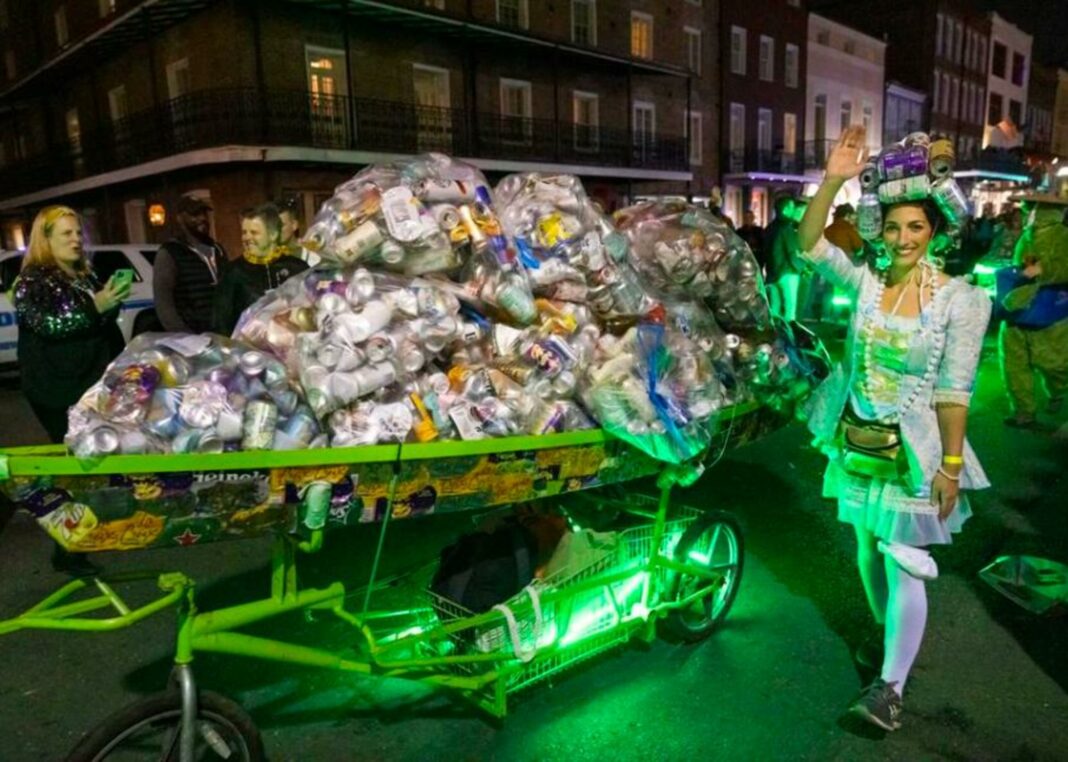New Orleans nonprofits work to reduce trash and waste at the iconic annual festival.
Mardi Gras, Louisiana's beloved Carnival season, is spectacular and unforgettable. It’s also tremendously wasteful. Costumed and masked riders on elaborate floats toss free gifts called “throws” to eager crowd members — items ranging from colored plastic beads, plastic cups, and toys to glitter-bedecked shoes and faux coconuts. In New Orleans, an estimated 1,500 tons (30,000) of beads and cups land on streets and sidewalks each year (or are thrown in the trash), while forty-six tons (93,000 pounds) of beads wind up in street drainage systems. Green is one of Mardi Gras' three official colors — purple, green, and gold were adopted in 1892 — yet the festival is anything but ”green” in the sustainable sense. (Festival season always starts on January 6, Twelfth Night. In 2024, the festival’s climax will be on February 13, preceded by two solid weeks of parades by krewes — private organizations who have themed floats and costumed members.)

But some locals are doing their best to change things. In 2020, citing the statistics above, the New Orleans City Council passed a resolution urging the use of recycled, sustainable, and quality, hand-made “throws” and asking revelers to prevent beads from clogging storm drains and landfills.
Kevin Fitzwilliam, a New Orleans native who owns Atlas Beads, which sells Mardi Gras necklaces and bracelets made from recycled magazine paper by a women's co-op in Uganda, has been working for 15 years to reduce the festival’s waste. “Mardi Gras is incredibly beautiful, and I’ve always loved it for its amazing creativity. Growing up here, students made art projects like building miniature floats from shoe boxes, costuming, and so on. There’s nothing like it.” But Fitzwilliam, who lives a half-block off the Uptown parade route, became disturbed and embarrassed by the “mind-boggling” amount of trash.

“On certain days, there might be five parades rolling on the same route. Each parade might have an average of 30 floats, many double-deckers, and some are multi-section floats. The result: there’s trash everywhere, and the ground is covered in so much plastic that you can often slip on the street.” In addition, there are health dangers associated with plastic beads due to toxic chemicals in the mass-produced versions.
Fitzwilliam hosted a radio show on environmental topics from 2011 to 2014, partnering with local groups like the Loyola University Center for Environmental Communication and the New Orleans Food and Farm Network, and discussed the “greening of Mardi Gras” each season. He began researching alternatives to mass-produced plastic beads in 2016, contacting organizations worldwide to find artisans to produce attractive hand-crafted throws. Over time, he developed relationships with two nonprofits associated with Ugandan women who make jewelry from recycled magazine paper. To gain experience in starting a small business, he participated in an entrepreneurship program, Launch NOLA, and began meeting krewe members to urge them to buy sustainable throws from Atlas Beads. Some did, like the Krewe of Themis, a women-only krewe committed to social justice and diversity. When Grounds Krewe began offering sustainable throw packages online, Fitzwilliam reached more customers. Last year, about 3,000 Atlas Beads items were thrown in parades, he estimates. With dozens of parades for two weeks, this isn’t a lot. But it’s a start.
This year, Atlas Beads items will be sold at three King Cake companies in New Orleans: Breads on Oak, Laurel Street Bakery and King Cake Hub. The sugar- and cinnamon-filled cake, topped with purple, green, and gold icing or sprinkles, with fillings like pecan praline or cream cheese, is a Mardi Gras tradition.



– Courtesy of Breads on Oak
And Fitzwilliam hasn’t stopped at running Atlas Beads. The summer before the 2019 Mardi Gras, he and three other locals began organizing volunteer teams to manage six recycling stations on the Uptown route. These stations collected plastic bottles, metal cans and discarded beads in both 2019 and 2020. One of the organizers, Brett Davis, also founded Grounds Krewe, a nonprofit seeking to create a more sustainable Mardi Gras. In the spirit of the fun and ingenuity that characterize New Orleans, that nonprofit formed the Trashformers, volunteers who dress up as recycling superheroes or characters with playful names (Marie Cantoinette wears a headdress made of aluminum cans; Miss Read’s dress is made of newspapers), who collect trash while riding bike/shopping cart hybrids.
Fitzwilliam dresses as Hans Can Crusher, who crushes metal cans and speaks with an Arnold Schwarzenegger accent inspired by the old Saturday Night Live comedy sketch “Hans and Franz”, featuring body-builders who spoke like the Austria-born action movie star. “It gets straight to the heart of what we're trying to do — show that sustainability in Mardi Gras is fun, creative, fulfilling, and communal,” Fitzwilliam says. The group typically diverts up to twenty-five thirty-gallon bags of recyclables from landfills.




Other groups are also active in trying to green Mardi Gras. To prevent krewes and others from constantly buying new beads, the nonprofit ARC of Greater New Orleans employs people with intellectual disabilities to sort used beads by color and size, repackage them, and then sell the recycled beads.
But not everyone warms to the idea of a greener Mardi Gras. When Fitzwilliam rode in a krewe in 2000, older men bragged about how much money they spent to buy their throws, and how many they’d toss. When he said he bought no new beads because he had saved beads since he was a kid, they were annoyed. “I got the impression they thought I was going to cheapen their parade by throwing beads I already caught.”
“The real beauty of Mardi Gras,” Fitzwilliam says, “lies in the ability to create and display art, to costume, to dance, and be overwhelmed by the color and festiveness of the season. Along with many others, I want to preserve what’s beautiful but reduce the waste.”


